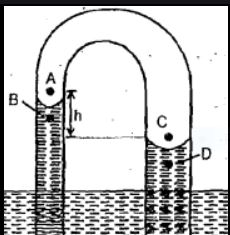Answer :

According to the question, the diameter of the first bore is
d1 = 3.0 mm = 3 × 10-3 m
The radius of the first bore is
r1 = 3/2 = 1.5 x 10-3 m.
The diameter of the second bore is
d2 =6mm
The radius of the second bore is
r2 = 6/2 = 3 x 10-3 mm
The surface tension of water is
s = 7.3 × 10-2 N /m
The angle of contact between the bore surface and water is
θ= 0
And the density of water is
ρ =1.0 × 103 kg/m-3
Acceleration due to gravity, g = 9.8 m/s2
Let h1 and h2 be the corresponding heights to which water rises in the first and second tubes.
As a result, the height differences can be writte using the expression of height
![]()
![]()
![Rendered by QuickLaTeX.com {{h}_{1}}-{{h}_{2}}=\frac{2s\cos \theta }{\rho g}\left[ \frac{1}{{{r}_{1}}}-\frac{1}{{{r}_{2}}} \right]](https://www.learnatnoon.com/s/wp-content/ql-cache/quicklatex.com-71fd02949c931ed59cbcff7c6f268203_l3.png)
![Rendered by QuickLaTeX.com {{h}_{1}}-{{h}_{2}}=\frac{2\times 7.3\times {{10}^{-2}}\times 1}{{{10}^{3}}\times 9.8}\left[ \frac{1}{1.5\times {{10}^{-3}}}-\frac{1}{3\times {{10}^{-3}}} \right]](https://www.learnatnoon.com/s/wp-content/ql-cache/quicklatex.com-f431fc8160669f34adbc9b0c24226178_l3.png)
![]()
Therefore, 2.482 mm is the difference in the water levels of the two arms.
